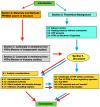Aerosol Emissions from Heated Tobacco Products: A Review Focusing on Carbonyls, Analytical Methods, and Experimental Quality
- PMID: 38133348
- PMCID: PMC10747376
- DOI: 10.3390/toxics11120947
Aerosol Emissions from Heated Tobacco Products: A Review Focusing on Carbonyls, Analytical Methods, and Experimental Quality
Abstract
We provide an extensive review of 17 independent and industry-funded studies targeting carbonyls in aerosol emissions of Heated Tobacco Products (HTPs), focusing on quality criteria based on the reproducibility of experiments, appropriate analytic methods, and puffing regimes. Most revised studies complied with these requirements, but some were unreproducible, while others failed to consider analytical variables that may have affected the results and/or produced unrealistic comparisons. We also provide a review of the literature on the physicochemical properties of heated tobacco and HTP aerosols, as well as the evaluation of HTPs by regulatory agencies, addressing various critiques of their relative safety profile. The outcomes from the revised studies and regulatory evaluations tend to agree with and converge to a general consensus that HTP aerosols expose users to significantly lower levels of toxicity than tobacco smoke.
Keywords: aerosols; analytical methods; carbonyls; heated tobacco products.
Conflict of interest statement
The authors declare no conflict of interest.
Figures
References
-
- Centers for Disease Control and Prevention (US) National Center for Chronic Disease Prevention and Health Promotion (US) Office on Smoking and Health (US) How Tobacco Smoke Causes Disease: The Biology and Behavioral Basis for Smoking-Attributable Disease: A Report of the Surgeon General. Centers for Disease Control and Prevention (US); Atlanta GA, USA: 2010. - PubMed
-
- World Health Organization . WHO Report on The Global Tobacco Epidemic, 2017. Monitoring Tobacco Use and Prevention Policies. World Health Organization; Geneva, Switzerland: 2017.
-
- Shapiro H. Burning Issues: Global State of Tobacco Harm Reduction 2020. Knowledge-Action-Change; London, UK: 2020.
Publication types
LinkOut - more resources
Full Text Sources



